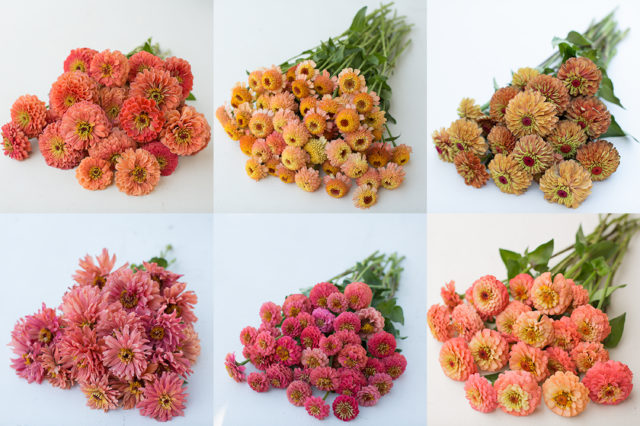Nothing says summer like a bunch of cheerful zinnias. These cheerful blooms come in a rainbow of colours, making them a must-have for all flower lovers.
The easiest cut flower to grow, they are a great first crop for beginning growers and are reliable, prolific producers for most flower farms and gardeners.
Every year I fall more and more in love with zinnias.
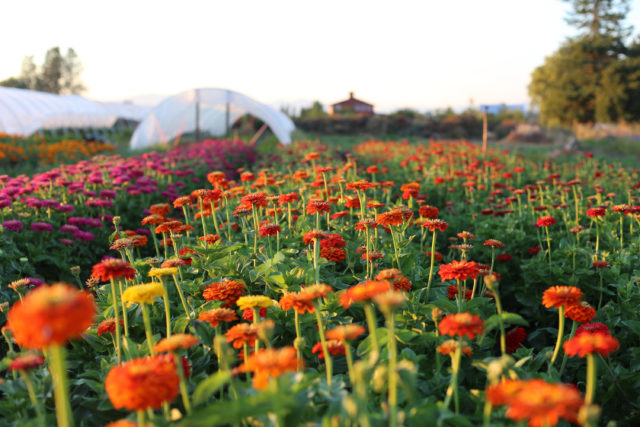 Zinnias dislike cold weather and should be planted after it has warmed up a bit. The majority of gardeners in warmer parts of the world can successfully direct seed their zinnias straight into the ground. Here in cool Washington, we start our plants in the greenhouse 4 to 6 weeks before the last spring frost.
Zinnias dislike cold weather and should be planted after it has warmed up a bit. The majority of gardeners in warmer parts of the world can successfully direct seed their zinnias straight into the ground. Here in cool Washington, we start our plants in the greenhouse 4 to 6 weeks before the last spring frost.
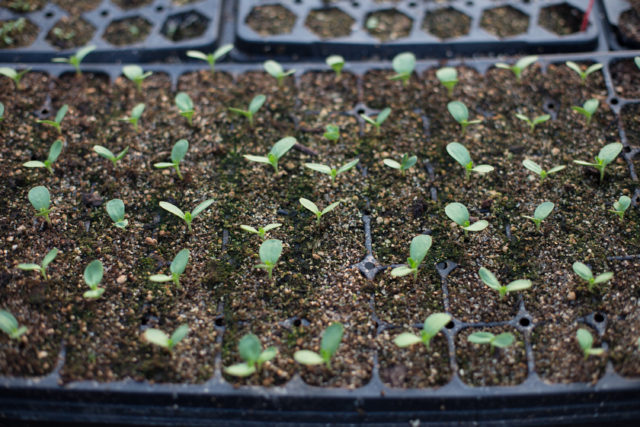 Around mid-May, once the weather has sufficiently warmed up and all danger of frost has passed, plants are tucked into the field. Like every flower grown on our farm, we try to give them the best start possible.
Around mid-May, once the weather has sufficiently warmed up and all danger of frost has passed, plants are tucked into the field. Like every flower grown on our farm, we try to give them the best start possible.
Planting beds are prepared by laying four lines of drip irrigation, roughly a foot (30.5 cm) apart, and then covered with pre-burned landscape fabric to control weeds. The plants are spaced nine inches (23 cm) apart with five rows per bed.
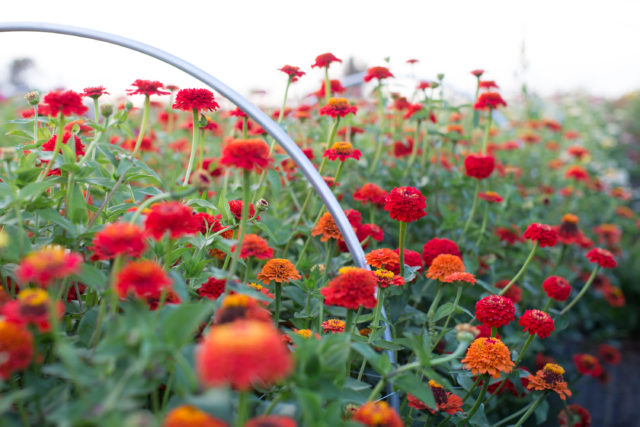 If given good soil and a steady supply of water, plants can grow huge and require support. Hortonova netting is stretched horizontally about 12 inches (30.5 cm) above the ground. Metal hoops are used to hold the net in place. We made them with our Johnny's Quick Hoops Bender. You can use wooden stakes or metal stakes. As the plants grow, they push up through the grid of netting and get the support they need.
If given good soil and a steady supply of water, plants can grow huge and require support. Hortonova netting is stretched horizontally about 12 inches (30.5 cm) above the ground. Metal hoops are used to hold the net in place. We made them with our Johnny's Quick Hoops Bender. You can use wooden stakes or metal stakes. As the plants grow, they push up through the grid of netting and get the support they need.
 Zinnias thrive in full sun and love the heat. In addition to choosing a sunny spot, I always grow them in fabric to add heat.
Zinnias thrive in full sun and love the heat. In addition to choosing a sunny spot, I always grow them in fabric to add heat.
In the beginning, I was concerned zinnias would be plagued by disease, but since they are grown in such rich soil, this hasn't been an issue. To ensure a steady supply of these beautiful blooms all summer long, we succession sow zinnias every 2 to 3 weeks.
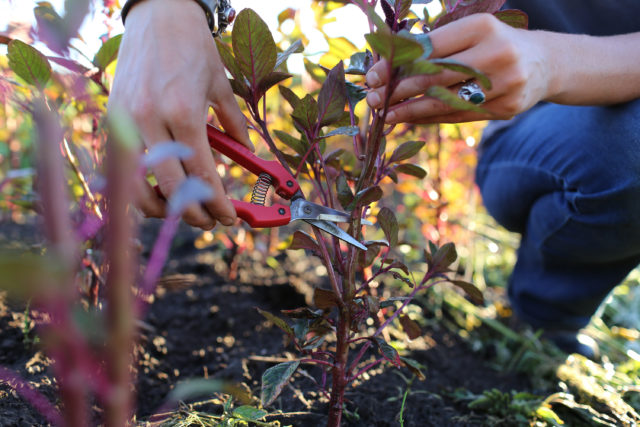 The key to getting the longest stems from your zinnias is pinching them when they are young. Take sharp pruners and cut the top 3 to 4 inches (8 to 10 cm) of the plant just above a set of leaves when plants are between 8 and 12 inches (20 to 30 cm) tall. In response, the plant sends up multiple stems from below where the cut was made, increasing flower production and stem length. The photo above shows a pinching with another plant.
The key to getting the longest stems from your zinnias is pinching them when they are young. Take sharp pruners and cut the top 3 to 4 inches (8 to 10 cm) of the plant just above a set of leaves when plants are between 8 and 12 inches (20 to 30 cm) tall. In response, the plant sends up multiple stems from below where the cut was made, increasing flower production and stem length. The photo above shows a pinching with another plant.
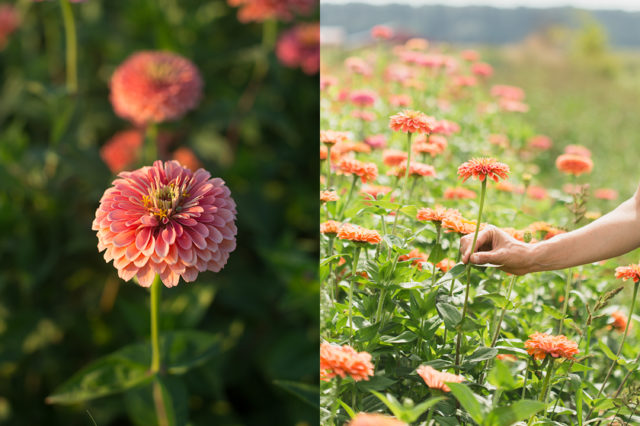 If you are not regularly harvesting your zinnias, be sure to deadhead any spent blooms to help the plant concentrate its energy on producing new flowers rather than seeding.
If you are not regularly harvesting your zinnias, be sure to deadhead any spent blooms to help the plant concentrate its energy on producing new flowers rather than seeding.
Zinnias should be picked when they are fully ripe, otherwise, they won't last in the vase. Use the "wiggle test" to determine when a zinnia is ready to be harvested. Simply grasp the stem about 8 inches (20 cm) below the flower head and gently shake it. If the stem is droopy or bends, it is not ready to be cut. A stem that remains erect and is stiff is ready for harvest.
Zinnias are considered dirty flowers, so they benefit from a drop or two of bleach in their water. Flowers are very sensitive to cold, so don't put them in the cooler.
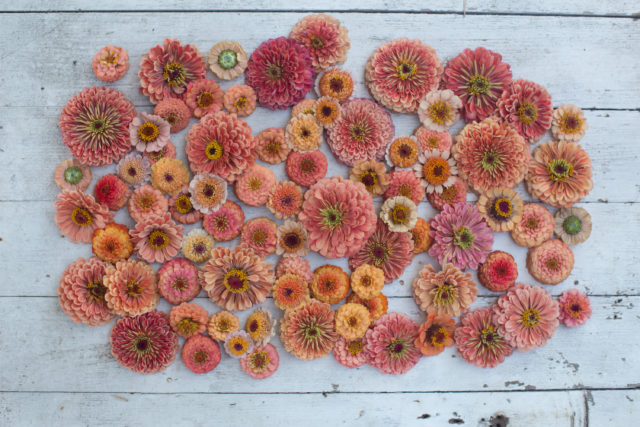 Zinnias come in every shape, colour, and size you can think of. Whatever your needs, there is a zinnia for you.
Zinnias come in every shape, colour, and size you can think of. Whatever your needs, there is a zinnia for you.
